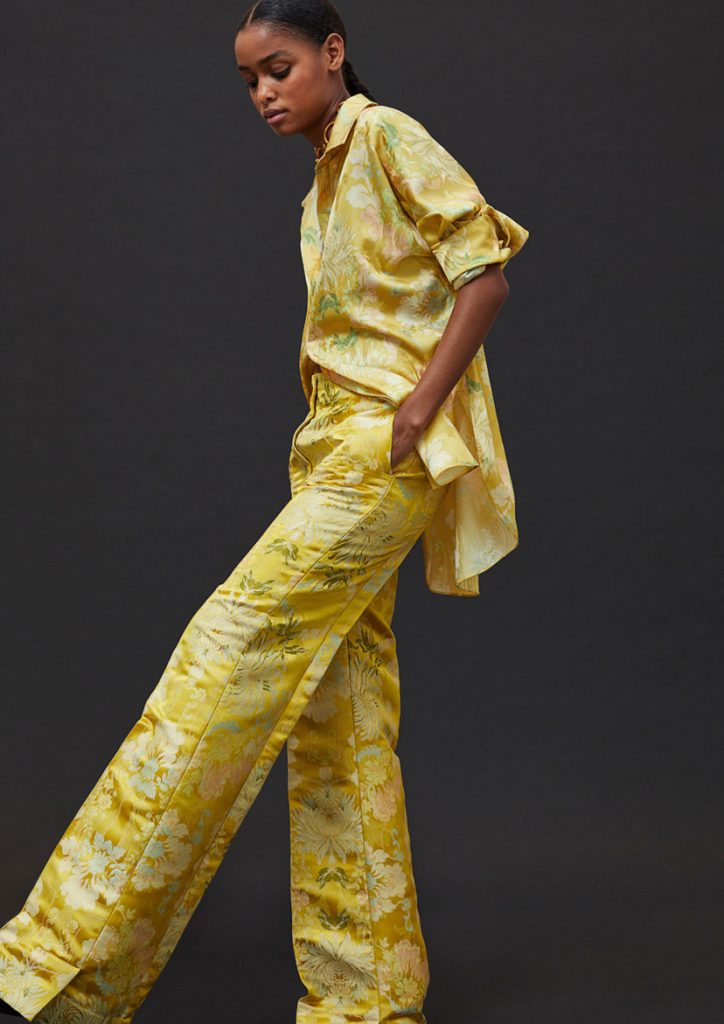H&M’s AW20 Conscious Exclusive (CE) collection is about creating beauty from waste. Almost every exquisite piece is crafted from a sustainably sourced material made from waste.
What’s normally thrown away is purposefully transformed into treasures to be loved and valued, allowing us to appreciate the potential of waste and be inspired by the creativity that comes from having to reuse things.
Innovative fabrics and processes that transform food crop waste into a natural fibre or fabrics made from sustainably sourced wood pulp, or use a unique garment-to-garment process, can be found in pieces such as opulent evening gowns in black and green jacquard taffeta, yellow jacquard or festooned with dusty green flowers, mingling with voluminous tops and tailored suiting.
Menswear also makes a return to Conscious Exclusive with a classic tuxedo, luxe suiting and floral print separates. Prints throughout the collection are inspired by floral wallpaper that has peeled off over time or tapestries from days gone by, while flower appliqués and moth motifs allude to both life and decay. Just in time for the festive season, Conscious Exclusive AW20 will be available at kw.hm.com from 1st December.
Dramatic volume, softly structured shapes and glamorous ruffles collude with an edgy undertone to create a darkly alluring collection for the holiday season. Key womenswear pieces include a yellow off-the-shoulder recycled polyester floral print dress with a voluminous ruffle along the chest, a dusty green short-sleeved mini-dress that floats by in a cloud of chiffon flowers made from closed-loop polyester, a black taffeta-like recycled polyester mini-dress with dark green woven-in flowers, statement puff sleeves, deep v-neckline and nipped- in waist, and a forest green body-con recycled polyester cocktail dress with a ruched bodice and asymmetrical puff shoulder.
There’s also an emphasis on versatile separates that can be dressed up or down, such as a black cropped blazer and wide trousers, both made from Naia Renew (a cellulosic fiber made from sustainably sourced wood pulp and recycled waste plastics, and blended with silk), a voluminous black fil-coupé recycled polyester sleeveless top with multi-colored woven-in flowers, and a black taffeta-like Naia Renew blouse with puff shoulders and voluminous sleeves.
Key menswear pieces include a black double-breasted recycled polyester, tencel and wool blend tuxedo with detachable flower embellishment, a yellow floral jacquard workwear- style jacket made from recycled polyester, and a black workwear shirt and pair of trousers made from Agraloop Hemp Biofiber, which is made from food crop waste.
Bold, edgy choker necklaces and earrings in a variety of recycled metals provide a rebellious contrast to the poetic clothing, with moth and grasshopper motifs as a nod to well-worn beauty. Gold and silver tones are effortlessly mixed and matched. High-heeled mules made from VEGEA, an innovative vegan leather, come with removable sock boots also in VEGEA that can be embellished with clip-on decorative shoe clips or chains in recycled metals.
A classic bowtie is made from Naia Renew, while sunglasses have a slimmer profile and supersonic vibe, and crafted from the state-of-the- art material Made of Air – a new material partly made from waste biomass and designed to combat climate change.
To tell us more about the line, Ann-Sofie Johansson, Creative Advisor at H&M whose role is to focus on sustainable design and the history/future of CE answered a few questions:
Eight years into CE, and the collections keep getting better year after year. Can you tell us more about the newest sustainable materials used in the AW20 CE Collection?
For AW20, there’s Agraloop Hemp Biofiber – a 2018 Global Change Award winner and launching worldwide with this collection – which converts food crop waste into a new natural fiber, in this case oil-seed hemp. Naia Renew is also new to H&M and launching worldwide with this collection.
Naia Renew cellulosic fiber is produced in a closed loop chemical system from circular sourced content – 60% wood pulp and 40% recycled waste plastics that includes post-consumer carpet fiber and other post-industrial plastic packaging materials.
What are some CE sustainable material innovations that are now applied in H&M’s wider collections? Can you give us examples?
It’s almost taken for granted now, but we first introduced Tencel in 2010 and it is now found widely across H&M’s collection – we’re one of the biggest users of the material. Tencel is derived from sustainable wood sources, harvested from certified and controlled sources following stringent guidelines, and comes from natural forests and sustainably managed plantations.
Tencel is also produced in an environmentally responsible closed loop production process, which transforms wood pulp into cellulosic fibers. A more recent example would be ECONYL, which made its debut in 2018. A 100% regenerated nylon fiber made from fishnets and other nylon waste, ECONYL, can be found across the H&M Group as well as the main H&M collections.
Why was waste the key subject and inspiration behind the fundamentals of this CE AW20 collection?
For AW20, we really wanted to be trailblazers – pushing the limits of creativity and sustainable fashion – by creating beauty from waste, which obviously has such negative connotations and realities. So nearly every exquisite piece is crafted from a sustainably sourced material made from waste. What’s normally thrown away is purposefully transformed into treasures to be loved and valued, allowing us to appreciate the potential of waste and be inspired by the creativity that comes from having to reuse things.
Agraloop Hemp Biofiber is the one of the newest, defining sustainable materials introduced for CE AW20. What is so special about this material? How did this material evolve into everyday classics like workwear shirts and trousers?
Agraloop transforms low-value agricultural waste into high-value and new natural fiber that’s then applied to yarn or textiles. For this collection, the Agraloop is made from oil-seed hemp, but the Biofiber can also be made from wheat, rice straws, pineapple leaves and sugarcane. Around the world, crop residues are many and too much to compost effectively. This waste is normally left to rot or burn, creating methane pollution, crop disease and air pollution, but with Agraloop this waste becomes a valuable resource.
For Conscious Exclusive AW20, Agraloop Hemp Biofiber can be found in a blazer, overshirt and trousers, where it lends an elegant and durable element, plus a natural hand feel.
Where do you see the CE concept going in 2021?
We’ll definitely continue exploring new sustainably sourced materials, which are often at the cutting edge of innovation and make their debut at H&M with Conscious Exclusive to be later scaled up and used in the main collections. We’ll also continue to be driven by curiosity and a hope for the future of fashion.
We also had a few more questions for designer Ella Soccorsi, who focused on the collection’s inspiration, design and materials:
This CE collection is pushing the envelope, literally putting waste front and center and positively using it as a way to present hope. How did this concept inspire your designs for this collection?
As a design team, we talked a lot about wanting a world based on a positive future rather than continuing on the dangerous path the planet is currently on. The selection of sustainably sourced materials made from waste was therefore intentional, and in this way, we’ve created something beautiful from waste and learned to appreciate the value of what’s around us.
It also inspired the prints in the collection – one comes from a floral wallpaper that has peeled off over time, another took cues tapestries from days gone by, while flower appliqués and moth motifs throughout allude to both life and decay.

How has working on this CE collection been different from previous CE collections?
I think because we had a strong focus on waste, our minds were very much on transformation and challenging what is considered “waste” to begin with. Which is very different than focusing a collection on, say, a historical figure or era. We also brought back some menswear for this collection, which we’re very excited about, and of course, we’re in the middle of a global pandemic, which affected everything from working together in the studio to production.
What was it like working with CE’s signature sustainable materials for Autumn Winter? Any challenges?
It’s always very exciting to work with such innovative sustainable materials, which for AW20 was made even more exciting because there are two making their worldwide launch – Agraloop Hemp Biofiber and Naia Renew. In terms of challenges, there’s often some amount of trial and error with obtaining the look and feel we all want, but we’re really happy to work with so many of these amazing innovators and factories.
How did you decide on how each material can be best used to create a one-of-a-kind garment?
There’s a lot of research and testing involved with the materials we use in Conscious Exclusive because we’re often incorporating new, innovative fabrics. We work closely with our industry partners in this, and sometimes we just know exactly what we want – say, for example, a jacquard woven with recycled polyester – and sometimes we let our instincts about a material’s structure or hand feel guide us.
What are some of your favorite pieces from this collection?
From all the dresses, the long multi-tiered dress in the floral print is probably my favorite, but I really love the black cropped blazer and matching wide-leg trousers. With the high waist, I’d also add the chain belt, which can also be worn as a necklace. The gold and silver chain has a rose flower embellishment and a grasshopper decoration, which would be subtle additions to a monochrome look.
Shop the H&M Conscious Exclusive AW20 collection online at kw.hm.com and through the H&M MENA app from December.











